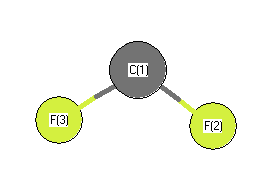Vibrational Frequencies calculated at B2PLYP=FULLultrafine/6-311G**
| Mode Number |
Symmetry |
Frequency
(cm-1) |
Scaled Frequency
(cm-1) |
IR Intensities
(km mol-1) |
Raman Act
(Å4/u) |
Dep P |
Dep U |
|---|
| 1 |
A1 |
1245 |
1245 |
120.71 |
5.79 |
0.29 |
0.45 |
| 2 |
A1 |
675 |
675 |
3.97 |
1.75 |
0.51 |
0.68 |
| 3 |
B2 |
1131 |
1131 |
370.38 |
5.09 |
0.75 |
0.86 |
Unscaled Zero Point Vibrational Energy (zpe) 1525.9 cm
-1
Scaled (by 1) Zero Point Vibrational Energy (zpe) 1525.9 cm
-1
See section
III.C.1 List or set vibrational scaling factors
to change the scale factors used here.
See section
III.C.2
Calculate a vibrational scaling factor for a given set of molecules
to determine the least squares best scaling factor.
